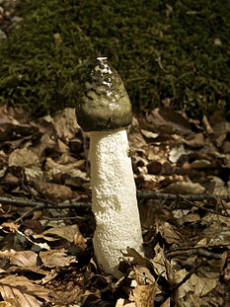
Roses are red,
Violets are blue.
Not all flowers smell nice
In fact some smell like---
Recently my Mum was with a friend in her garden, admiring a pigeon who had made her nest in a rose bush. Unfortunately this tranquil scene was brought to a sudden end, as the wind changed direction and a ghastly smell hit their noses. Mum told me later that it smelt exactly like a dead animal and so, fearing the worst, the two women began to hunt down the source. Eventually, at the back of an adjacent flower bed, they spotted a seething mass of green bottle flies. Thankfully they weren’t covering a rodent corpse or (as I expected when being told this story) a baby pigeon. Instead, the flies were excitedly swarming around a huge mushroom, the top of which was covered in a foul, grey substance—the source of the horrible stench.
A quick Google search revealed that the mushroom is called--fittingly--a Stinkhorn (pictured). The species can appear all over the world, though they are much more common in tropical regions. They mature extremely rapidly, growing from an egg under ground to full height within a day. They’re also very large. It turns out that the example my Mum saw was on the small side, at around fifteen centimetres, as Stinkhorns can reach thirty centimetres in height and five centimetres in diameter. That’s at a growth rate of up to fifteen centimetres in an hour.
The most remarkable thing about the Stinkhorn mushroom is its method of spore dispersal. Most mushrooms rely on wind or water to carry their spores away but the Stinkhorn behaves more like a flower, using insects to do the work. Its olive-coloured cap secretes a foul smelling substance, which also contains its spores. The spore mass smells like a mixture of carrion (dead animal) and dung, and attracts the kind of flies and other insects you usually see hanging around these smelly things. The insects get the spores all over their legs, then fly away and disperse them elsewhere.

Most plants attract insects through bright colours and sweet nectar, and I wondered if any others beside the Stinkhorn used this unique method of spore or seed dispersal. Another Google led me to a range of flower species known as Carrion Flowers, all of which are as strange as the Stinkhorn. The Titan Arum from Indonesia is known as the ‘corpse flower’ (though the plant is actually both male and female flowers growing together) and grows to a staggering three metres high. It has a giant set of petals, another three metres in circumference, with a huge spadix resembling a French baguette rising out the middle. Like the Stinkhorn the flower smells like rotting meat, but it takes the illusion even further, with its petals actually resembling decomposing flesh, while the spadix is human body temperature. Carrion-eating beetles and flesh flies love this, and happily help to pollinate the flower.
Another carrion flower is the Rafflesia (pictured), which is also from Indonesia and is the largest individual flower on earth at one metre in diameter. It’s a parasite, and so doesn’t have a stem or leaves of its own, but grows out the side of a host plant. The Rafflesia also looks like rotting meat—to me, its petals look like huge tongues—and smells just as bad. The Dead Horse arum is a fly-trap native to Sardinia and Corsica. It also generates its own heat, and emits a terrible odour which attracts flies and beetles. They force their way down the neck of the flower and into an inner chamber, and are trapped by the spines which grow there. After a day or so the male part of the flower matures, producing pollen, at which point the spines wither and allow the flies to leave, being coated with pollen as they go.
There are plenty of other Carrion flowers, and horrible smelling fungi. I’m not sure I’d like to smell them myself, but I think it’s fascinating that such a method of seed dispersal exists.
Images: https://upload.wikimedia.org/wikipedia/commons/thumb/2/2d/Phallus_impudicus_LC0235.jpg/234px-Phallus_impudicus_LC0235.jpg
https://upload.wikimedia.org/wikipedia/commons/thumb/a/af/Rafflesia_sumatra.jpg/250px-Rafflesia_sumatra.jpg

0 Comment:
Be the first one to comment on this article.